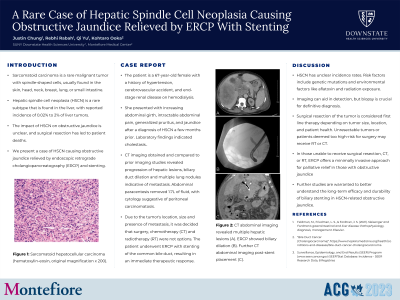Sunday Poster Session
Category: Biliary/Pancreas
P0056 - A Rare Case of Hepatic Spindle Cell Neoplasia Causing Obstructive Jaundice Relieved by ERCP With Stenting
Sunday, October 22, 2023
3:30 PM - 7:00 PM PT
Location: Exhibit Hall

Has Audio

Justin Chung, MD
SUNY Downstate Health Sciences University
Brooklyn, NY
Presenting Author(s)
Justin Chung, MD1, Rebhi Rabah, MD1, Qi Yu, MD, MPH2, Kohtaro Ooka, MD3
1SUNY Downstate Health Sciences University, Brooklyn, NY; 2SUNY Downstate Health Sciences University/NYCHHC Kings County Hospital, Brooklyn, NY; 3Montefiore Medical Center, Bronx, NY
Introduction: Sarcomatoid carcinoma is a rare malignant tumor with spindle-shaped cells, usually found in the skin, head, neck, breast, lung, or small intestine. Hepatic spindle cell neoplasia (HSCN) is a rare subtype that is found in the liver, with reported incidence of 0.02% to 2% of liver tumors. The impact of HSCN on obstructive jaundice is unclear, and surgical resection has led to patient deaths. We present a case of HSCN causing obstructive jaundice relieved by endoscopic retrograde cholangiopancreatography (ERCP) and stenting.
Case Description/Methods: The patient is a 67-year-old female with a history of hypertension, cerebrovascular accident, and end-stage renal disease on hemodialysis. She presented with increasing abdominal girth, intractable abdominal pain, generalized pruritus, and jaundice after a diagnosis of HSCN a few months prior. Laboratory findings indicated cholestasis. CT imaging obtained and compared to prior imaging studies revealed progression of hepatic lesions, biliary duct dilation and multiple lung nodules indicative of metastasis. Abdominal paracentesis removed 1.7L of fluid, with cytology suggestive of peritoneal carcinomatosis. Due to the tumor's location, size and presence of metastasis, it was decided that surgery, chemotherapy (CT) and radiotherapy (RT) were not options. The patient underwent ERCP with stenting of the common bile duct, resulting in an immediate response. Bilirubin and alkaline phosphatase decreased significantly. The patient was discharged without complications and initiated home hospice care.
Discussion: HSCN, a rare subtype of hepatocellular carcinoma predominantly seen in middle-aged to older adults, has incidence rates close to 2%. Risk factors include genetic mutations and environmental factors like aflatoxin and radiation exposure. Symptom presentation varies, so imaging can aid in detection, but biopsy is crucial for definitive diagnosis. Surgical resection of the tumor is considered first line therapy depending on tumor size, location, and patient health. Unresectable tumors or patients deemed high-risk for surgery may receive RT or CT. This case highlights the use of ERCP with stenting to provide symptomatic and palliative relief in patients with HSCN causing obstructive jaundice. This minimally invasive approach can enhance the quality of life in those unable to receive surgical resection, CT or RT. Further studies are warranted to better understand the long-term efficacy and durability of biliary stenting in HSCN-related obstructive jaundice.

Disclosures:
Justin Chung, MD1, Rebhi Rabah, MD1, Qi Yu, MD, MPH2, Kohtaro Ooka, MD3. P0056 - A Rare Case of Hepatic Spindle Cell Neoplasia Causing Obstructive Jaundice Relieved by ERCP With Stenting, ACG 2023 Annual Scientific Meeting Abstracts. Vancouver, BC, Canada: American College of Gastroenterology.
1SUNY Downstate Health Sciences University, Brooklyn, NY; 2SUNY Downstate Health Sciences University/NYCHHC Kings County Hospital, Brooklyn, NY; 3Montefiore Medical Center, Bronx, NY
Introduction: Sarcomatoid carcinoma is a rare malignant tumor with spindle-shaped cells, usually found in the skin, head, neck, breast, lung, or small intestine. Hepatic spindle cell neoplasia (HSCN) is a rare subtype that is found in the liver, with reported incidence of 0.02% to 2% of liver tumors. The impact of HSCN on obstructive jaundice is unclear, and surgical resection has led to patient deaths. We present a case of HSCN causing obstructive jaundice relieved by endoscopic retrograde cholangiopancreatography (ERCP) and stenting.
Case Description/Methods: The patient is a 67-year-old female with a history of hypertension, cerebrovascular accident, and end-stage renal disease on hemodialysis. She presented with increasing abdominal girth, intractable abdominal pain, generalized pruritus, and jaundice after a diagnosis of HSCN a few months prior. Laboratory findings indicated cholestasis. CT imaging obtained and compared to prior imaging studies revealed progression of hepatic lesions, biliary duct dilation and multiple lung nodules indicative of metastasis. Abdominal paracentesis removed 1.7L of fluid, with cytology suggestive of peritoneal carcinomatosis. Due to the tumor's location, size and presence of metastasis, it was decided that surgery, chemotherapy (CT) and radiotherapy (RT) were not options. The patient underwent ERCP with stenting of the common bile duct, resulting in an immediate response. Bilirubin and alkaline phosphatase decreased significantly. The patient was discharged without complications and initiated home hospice care.
Discussion: HSCN, a rare subtype of hepatocellular carcinoma predominantly seen in middle-aged to older adults, has incidence rates close to 2%. Risk factors include genetic mutations and environmental factors like aflatoxin and radiation exposure. Symptom presentation varies, so imaging can aid in detection, but biopsy is crucial for definitive diagnosis. Surgical resection of the tumor is considered first line therapy depending on tumor size, location, and patient health. Unresectable tumors or patients deemed high-risk for surgery may receive RT or CT. This case highlights the use of ERCP with stenting to provide symptomatic and palliative relief in patients with HSCN causing obstructive jaundice. This minimally invasive approach can enhance the quality of life in those unable to receive surgical resection, CT or RT. Further studies are warranted to better understand the long-term efficacy and durability of biliary stenting in HSCN-related obstructive jaundice.

Figure: Figure 1: CT abdominal imaging revealed multiple hepatic lesions (A). ERCP showed biliary dilation (B). Further CT abdominal imaging post-stent placement (C).
Disclosures:
Justin Chung indicated no relevant financial relationships.
Rebhi Rabah indicated no relevant financial relationships.
Qi Yu indicated no relevant financial relationships.
Kohtaro Ooka indicated no relevant financial relationships.
Justin Chung, MD1, Rebhi Rabah, MD1, Qi Yu, MD, MPH2, Kohtaro Ooka, MD3. P0056 - A Rare Case of Hepatic Spindle Cell Neoplasia Causing Obstructive Jaundice Relieved by ERCP With Stenting, ACG 2023 Annual Scientific Meeting Abstracts. Vancouver, BC, Canada: American College of Gastroenterology.
